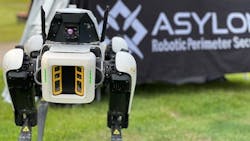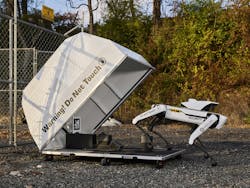Key Highlights
- With cargo theft on the rise, Asylon is offering fleets the next step in security: The DroneDog-2
- Offering cost reduction and more patrols, the robot is tough and can navigate unusual terrain, even those with other moving objects, like people and trucks
- The DroneDog-2 also comes with a rugged DogHouse unit where it can safely recharge
To curb rising cargo theft rates in the trucking sector, an automated security solution provider called Asylon has gone to the dogs. The company’s DroneDog-2, a modified Boston Dynamics’ Spot four-legged robot, was programmed to perform autonomous paw patrol for high-value facilities such as trucking terminals, warehouses, dealerships, and service yards, with capabilities including 24/7 perimeter security, anomaly detection, and rapid incident response.
DroneDog has plenty of tricks, such as picking up potential trespassers’ heat signatures with its infrared camera, live-streaming video, scanning license plates, and can integrate with a company’s existing alarm or surveillance systems through Asylon’s DroneIQ platform.
And when a threat is identified, Asylon’s human operators at Robotic Security Operations Center can remotely control the roving drone. Asylon, which also offers aerial drone support, provides full-stack support and maintenance on its bots.
It even has its own ruggedized DogHouse, a protective dome where it can recharge (and possibly plot the overthrow of humans).
Why DroneDog could be a fleet’s best friend
Dennis Crowley, Asylon’s chief growth officer, believes the extensive features make DroneDog a cost-effective security solution for fleet facilities with more than 25 tractors and trailers, or those spanning multiple acres. Other areas could include large overnight truck parking areas and distribution centers.
“DroneDog excels in securing high-theft-risk zones, remote or low-visibility areas, and expansive perimeters that are cost-prohibitive for traditional guard patrols,” he said, adding DroneDog offers a “typical cost reduction of up to 30% versus traditional guards, and a 200% increase in patrol frequency.”
And more frequent patrols may be needed as cargo theft becomes a more popular criminal pursuit, jumping 93% from 2022 to 2024, according to CargoNet. Asylon notes 2025 could be even higher as imports increased ahead of tariffs going into effect. That means there’s more extra inventory left vulnerable to thieves.
DroneDog can help not only prevent future cargo theft by serving as a visible deterrent and early warning system to notify employees and authorities for quick response, but also any vandalism or theft of vehicles and valuable parts, such as catalytic converters.
Specific customers and crime-stopping events are kept confidential, but Crowley said “DroneDog has identified and reported numerous security events across deployments—including suspicious individuals, unauthorized vehicle activity, and perimeter breaches.”
He added that the system has completed more than 76,000 patrols and identified more than 2,000 actionable security events in less than two years.
You’d think the last thing a fleet needs is another machine moving around a busy lot, but Boston Dynamics has spent well over a decade perfecting its bipedal ATLAS and quadrupedal Spot and equipping them with sensors and logic to coexist among humans and other moving objects. Even the prototype version of Spot could withstand a kick.
As Crowley notes, Spot, and thus DroneDog, has “advanced obstacle detection, terrain awareness, and precision navigation to operate safely—even in dynamic, industrial environments.”
If deployed in a high-traffic terminal or port, Asylon will geofence patrol routes away from heavy vehicle lanes, schedule patrols to avoid peak traffic hours, and add human oversight. DroneDog can also emit audible warnings and strobe lights to alert workers—and trespassers—to its presence.
And maybe someday, Asylon will equip DroneDog with even more effective deterrents, such as a net gun...
About the Author

John Hitch
Editor-in-chief, Fleet Maintenance
John Hitch is the award-winning editor-in-chief of Fleet Maintenance, where his mission is to provide maintenance leaders and technicians with the the latest information on tools, strategies, and best practices to keep their fleets' commercial vehicles moving.
He is based out of Cleveland, Ohio, and has worked in the B2B journalism space for more than a decade. Hitch was previously senior editor for FleetOwner and before that was technology editor for IndustryWeek and and managing editor of New Equipment Digest.
Hitch graduated from Kent State University and was editor of the student magazine The Burr in 2009.
The former sonar technician served honorably aboard the fast-attack submarine USS Oklahoma City (SSN-723), where he participated in counter-drug ops, an under-ice expedition, and other missions he's not allowed to talk about for several more decades.

